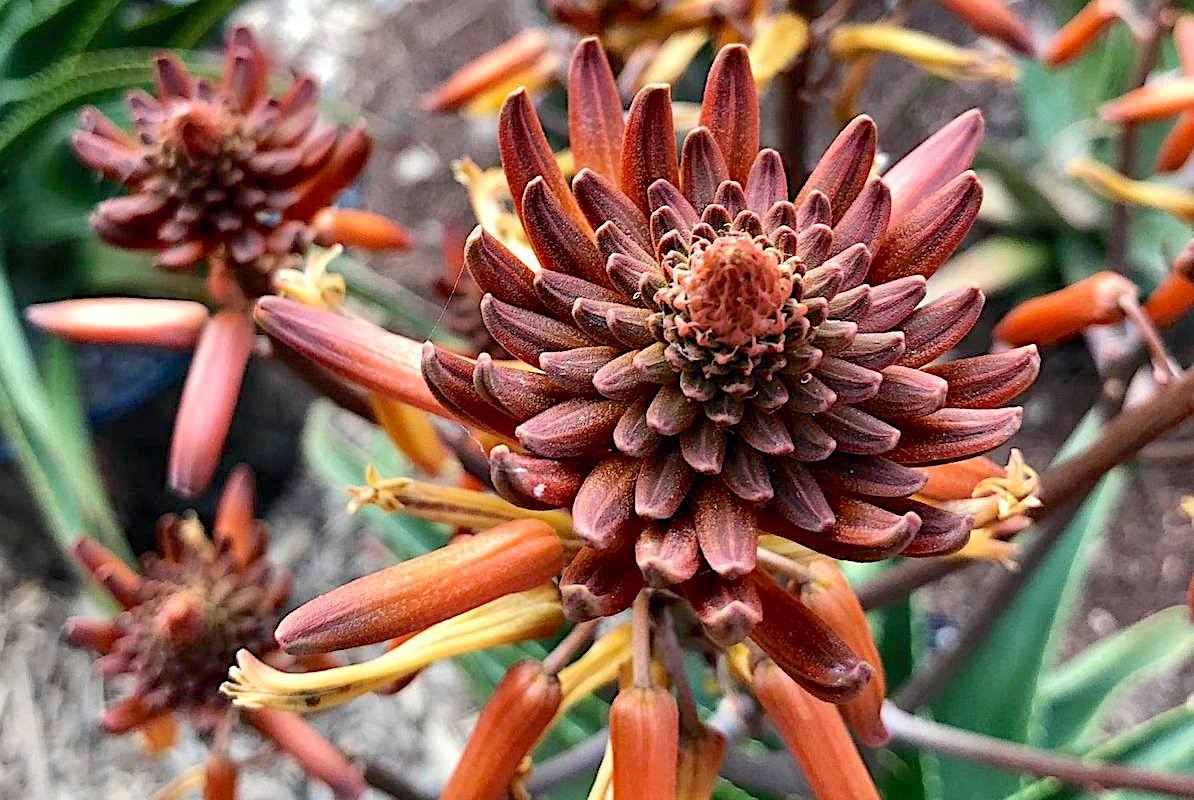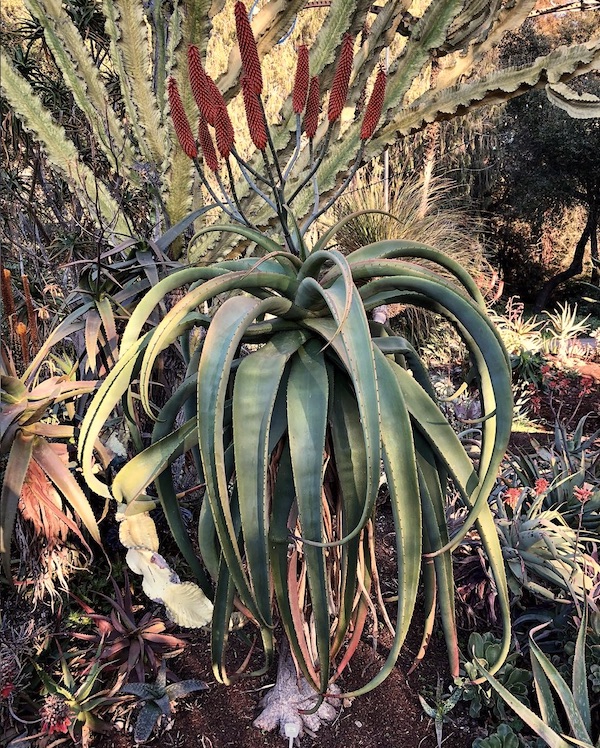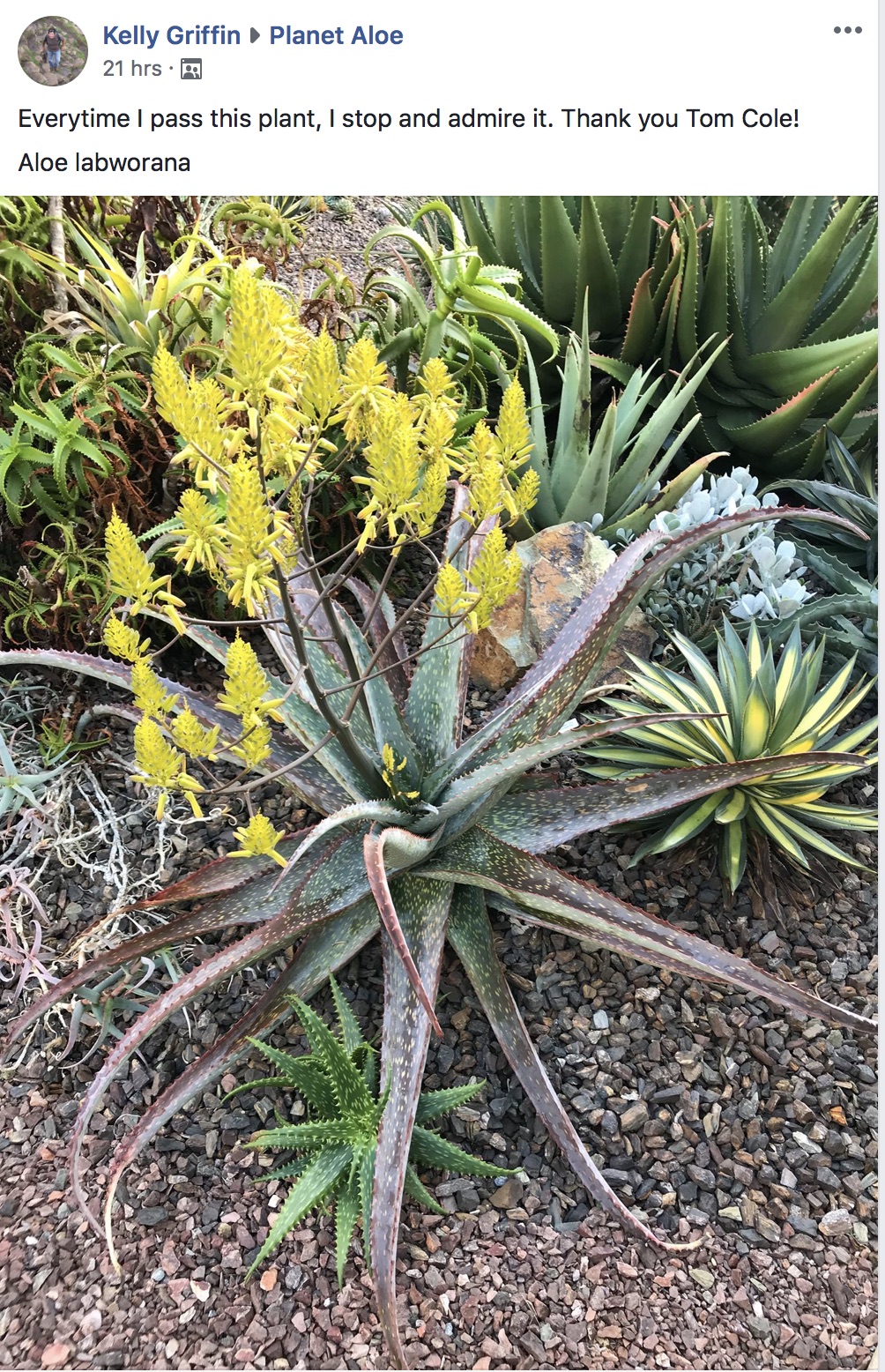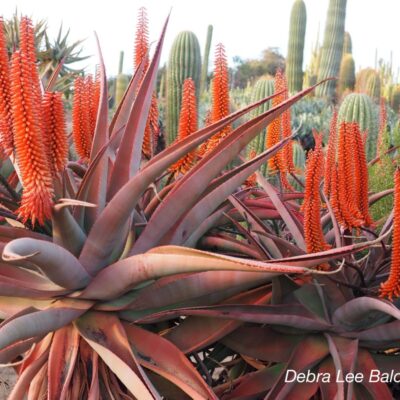
Tom Cole’s Remarkable Rare Aloe Nursery
On a recent trip to Santa Barbara, I visited Tom Cole at his home nursery, Cold Spring Aloes, in Montecito near Lotusland. In my new video, you'll discover how Tom's remarkable efforts are expanding and enhancing the world of succulents and garden design. Above: Aloe lukeana, red form (Tom Cole photo).
The Aloe that started it all
Tom Cole grew up around succulents in Santa Barbara, and although his wasn't a gardening family, he recognizes a remarkable aloe when he sees one. When exploring the "odd mountain" near where he lived and worked in East Africa, he ran across native species not seen elsewhere. Two decades ago, Tom brought home seed from a Mozambique aloe that had looked him in the eye (it was that tall). "Aloe excelsa started it all," he says, stroking its six-foot descendent's downward-curving leaves.

Aloe excelsa: The aloe that started it all (Tom Cole photo)
Seed-Grown Species
Although Tom's main focus is overseeing humanitarian aid efforts in Africa (supported by foundations such as Oprah Winfrey's), his aloe-collecting hobby has grown---literally---into a small botanical garden and nursery. Today he has hundreds of exotic, seed-grown Aloe species in pots and in the garden. Apart from a few aloes from regions of Africa that dislike Southern California's winter rains, Tom's specimens look as good as (if not better than) those in habitat.

Tom shows Aloe lukeana, named after his late brother.
Solely by word-of-mouth, Cold Spring Aloes attracts collectors and professional landscapers alike. To conserve little-known Aloe species, Tom shares seeds with the Huntington Botanical Gardens, the Institute for Aloe Studies, and discerning growers. "I feel very blessed in my work that I get to be in areas of the world that almost everyone else who grows aloes doesn't have the opportunity to visit," he says, adding that his goal is "to get these species out there, because they're really tremendous."

Famed aloe expert Kelly Griffin gives kudos to Tom Cole on Facebook (screen capture)
Keeping species pure
Winter is most aloes' bloom season, but at any time of the year at least a few are in flower. He encloses seed capsules with mesh bags so irreplaceable one-of-a-kinds don't hybridize. "Aloes are promiscuous," Tom explains. "They're easily cross-pollinated by bees and hummingbirds." He wants pure seed; with over 600 known species of Aloe, he has no interest in hybrids.
Tom's discoveries
Tom discovered and named three Aloe species: A. wanalensis, A. butiabana, and A. lukeana; and subspecies A. labworana ssp. longifolia. He based the names on locations for all except a glossy green one. This he named in memory of "one of my heroes and mentors," his late brother Luke, who in 2009 at 46 died in a car accident in Uganda. After noting the tragedy, Tom fell silent then added, "he lives on in these plants."

Map of Africa. Uganda is near the lake at middle right.
More About Tom Cole
Tom Cole co-authored with Tom Forrest A Field Guide to the Aloes of Uganda.
He is co-founder of African Women Rising, a community-based organization empowering thousands of women in post-war Uganda.
Cold Spring Aloes is open by appointment only. No online sales. 805/455-6440; Thomas.chappell.cole@gmail.com; Instagram: @Aloejourney #coldspringaloes
Related info on this site
Aloes: Uses, Photos, IDs & Varieties
Aloes: How To Grow & Varieties All about aloes plus a photo gallery of aloes ID’d and in bloom See All Succulent Types Aeonium Agaves Aloes Cactus Crassula Echeveria Euphorbias Ice Plants Kalanchoe Portulacaria Senecio About Aloes There are dozens of species of Aloe, from tall trees to dwarf cultivars. Aloes typically have juicy, triangular leaves…
Midwinter Succulent Show: Big Aloes In Bloom
Above: Aloe ferox at Desert Theater nursery, Escondido, CA. From my video, Spectacular Aloes in Flower. Large, sculptural aloes with brilliant, Popsicle-like flowers make striking garden plants. Midwinter is peak aloe bloom season and an excellent time to see them in nurseries and landscapes. Aloe ferox, or Cape Aloe, might be considered a tree because of its height at maturity–6 to 8 feet with bloom…



By coincidence I received Tom’s book as a gift a few yrs ago. Great read. Because the book focuses on Aloes from a specific region it has more room to go into detail. Thanks for the interesting background on the author – it helps connect the dots between notable people in the field. I think it would be interesting to create a network graph of people in the space – whether designers, businesses, scientists, journalists etc. I get the sense it is a relatively small world.
Hi Hans — Thank you. I really enjoy meeting people like Tom who are making a significant impact on the world of succulents through their own fascination with a narrow segment of it. Not only is it fun to see someone pursue their passion so thoroughly, the results benefit all of us…more so as time passes. What they’re doing will change the way people see and enjoy succulents, and how they cultivate them for years to come.
Debra .
I would like to thank you for all we have been learning from You .
Thank you so much . Blessings
Alex
MeryFarm Gardens
Thank YOU, Alex! Much appreciated! This is what it’s all about.